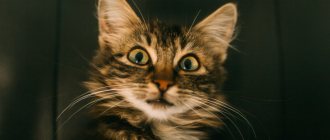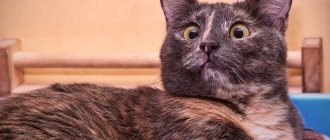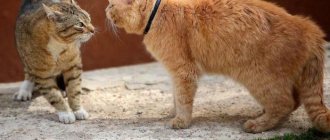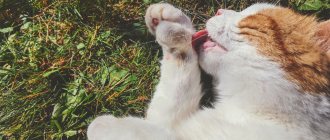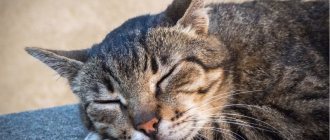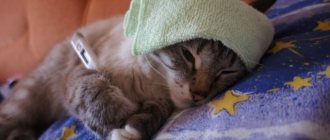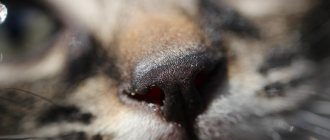Oddly enough, but a runny nose in cats is not a rare condition that occurs as a result of infection and other diseases. Accompanied by purulent or watery mucous discharge. In our article we will talk about how to identify this disease, the causes of its occurrence and consider the most common methods of treatment.
How to treat a runny nose in cats
A runny nose is liquid discharge from the nose of varying consistency, composition and color. In most cases, a runny nose is part of the normal nasal clearing process.
If your cat's nasal discharge continues for several hours, it is a clear symptom of a cold, inflammation, injury, or upper respiratory tract infection. Veterinary care is required to recognize the disease at an early stage.
Free consultation Moscow
+7(495)162-70-70
What to pay attention to
The symptoms of rhinitis directly depend on the cause that caused it. Basically the following can be observed:
- snot itself - of varying consistency and color (watery, slimy or thick; transparent, yellowish-gray or green), and a change in the shade of mucus secreted from the nose (green or yellow-green) is almost always a sign of a bacterial infection;
- lacrimation and sourness of the eyes (the nasal cavities are connected to the lacrimal canals, so very often tears are associated with a runny nose);
- the mucous membrane of the nasal passages swells and turns red, this makes breathing difficult and wheezing appears;
- the pet sneezes (snorts) and periodically rubs its face with its paws;
- in the presence of tumors, the muzzle may become asymmetrical, various curvatures may appear;
- nasal congestion is manifested by mouth breathing - this is clearly visible in the swelling of the cheeks;
- of the general symptoms of malaise: the temperature may rise, lethargy, apathy may appear, appetite decreases or disappears.
In addition to the main symptoms, for a more accurate diagnosis, you should prepare the following information for the veterinarian:
- Nature of discharge: constantly or exclusively in the evenings/mornings/after increased activity, in what body position.
- Flow abundantly or scanty and smeared.
- Do they dry out, forming crusts, or is the nose constantly wet?
- Both nostrils or one are involved in the process.
- When an animal sleeps, its mouth is open or closed.
- Is the cat bothered by a runny nose or does he not pay attention to the condition?
Why does my cat have a runny nose?
If your cat has nasal discharge, it is due to inflammation, injury, or infection of the mucous membranes in the nasal cavities or sinuses.
Nature of nasal discharge
- Watery discharge and sneezing
Localized irritation (foreign body), colds, allergic rhinitis, and the onset of a viral disease.
- Mucus discharge
Viral respiratory diseases - feline calicivirus and feline herpesvirus.
- Thick purulent yellow discharge
Bacterial infection, diseases of teeth and gums.
- Thick purulent discharge with an unpleasant odor
Formations in the nasal cavity - tumors and polyps.
- Bloody issues
Injuries and foreign bodies in the nose, chronic bleeding disorders and high blood pressure.
Often the discharge begins as watery, but gradually turns into mucous, and then purulent. This occurs with the development of an infectious disease.
Symptoms
To understand that your cat has some kind of problem, you need to pay attention to the following symptoms:
- Symptoms of viruses: runny nose, snot, suppuration of the eyes, vomiting, loss of appetite, diarrhea, while the general condition of the animal usually suffers. In this case, a doctor's consultation is necessary. Sometimes the presence of the virus in a pet can be fatal, and the time passes by for days.
- When a pet is allergic, symptoms such as nasal congestion, running snot, swollen and purulent eyes, impaired respiratory function, and itching appear.
- Symptoms of polyps and tumors: the animal rubs its nose with its paws, as if something is bothering it. As a result of a tumor, asymmetry and curvature may appear on the muzzle.
- Signs of the presence of a foreign body: the cat shakes its face, sneezes, and produces snot.
Tips you can use to relieve a runny nose
- Be sure to consult your veterinarian
- Regularly clean nasal discharge from your cat's face with warm, damp cotton wool.
- Try to get your cat to eat heated canned food.
- Make sure your cat has plenty of fresh water.
- Run a humidifier to keep your cat's nasal passages moist.
Call a veterinarian Moscow
+7(495)162-70-70
1 Inflammation of the mucous membranes of the nose and sinuses.
Rhinosinusitis.
Treatment may include nasal irrigation, broad-spectrum antibiotics to treat or prevent bacterial infections, and a dose of steroids to open the nasal cavity and sinuses. In severe cases, intravenous fluids and nutritional support may be required.
2 Upper respiratory tract infections
(viral, bacterial, fungal)
acute viral and bacterial infections such as.
Herpes virus, calicivirus, bordetellosis, chlamydia, mycoplasmosis and chronic respiratory diseases.
Treatment for upper respiratory tract infections depends on the severity. In cases with mild symptoms, URIs may resolve on their own within a couple of weeks. In other cases, additional treatment may be required.
- Antiviral drugs or antibiotics
- Drops for eyes and/or nose
- Steroids
- Subcutaneous fluids (in cases associated with dehydration)
If your cat has received the recommended vaccines, the risk of contracting these infections is greatly reduced.
3 Chronic upper respiratory diseases
Cats that have already recovered from severe acute viral infections such as feline calicivirus and feline herpesvirus are more susceptible to chronic upper respiratory disease, in which symptoms persist continuously or intermittently.
Unfortunately, there is no cure for chronic upper respiratory disease in cats, so treatment usually involves managing symptoms through systematic veterinary care and medications.
4 Trauma to the nasal cavity
Treatment in each case depends on the nature of the injury.
- Polyp, tumor, or foreign body in the nasal canal (usually accompanied by sneezing)
Surgical and drug treatment.
5 Eye problems (epiphora)
Dacryocystorhinostomy using various modifications, using an external and internal approach.
6 Oral and dental problems
Sanitation of the oral cavity with removal of diseased teeth.
7 Ear problems
Otitis
- ear drops
- novocaine blockade to reduce pain
- antibiotic therapy for 5-7 days
Prevention
To treat your cat less frequently for colds and runny noses of other etiologies, you should follow these simple recommendations:
- Say no to drafts! There is no room for drafts in rooms where children and pets are present.
- If your cat is prone to allergic diseases, do wet cleaning more often and protect it from “encountering” allergenic substances.
- Keep your pet away from outdoor cats and dogs.
- Do not place your four-legged pet's bed in a cold place.
- Carry out vaccinations and timely treatment against parasites and worms.
- Provide your pet with adequate nutrition, and do not forget about fortifying the food.
Main symptoms
If it is a cold, the main symptoms are usually the following:
- runny nose;
- lacrimation;
- lethargy;
- conjunctivitis;
- labored breathing.
The risk is that due to simple symptoms, you can miss a dangerous disease with similar manifestations.
It can be:
- severe infectious diseases, the positive outcome of which depends only on prompt access to a veterinary clinic;
- parasites for which the pet must be treated;
- chronic diseases passed on from the mother and requiring immediate diagnosis and treatment.
Treatment
Since a runny nose often becomes only an indicator of a viral infection or other inflammation in the body, it will be necessary to treat not so much it as the root cause. It is not always possible to independently find out the true source of the disease. Therefore, it is very important to consult a veterinarian, conduct a diagnosis and follow the treatment plan.
It will be very difficult to cure a stray cat from a runny nose if he is not provided with comfortable conditions: warmth, food, vitamins and scheduled medications.
Useful video on how to put drops in a cat's nose:
Colds and rhinitis
If your cat's cold cannot be treated at home, then you need to seek help from a veterinarian. The clinic will examine the cat and prescribe the necessary medications. It is not recommended to use medications without a prescription from a specialist. Typically treatment includes:
- Taking antipyretics if the temperature persists.
- Expectorants.
- Antibiotics.
- Vitamins.
- Droppers (to avoid dehydration).
Drugs used:
- Maxidin. Drop into the nose to stimulate the immune system.
- Anandin. Antiviral and immune system stimulant.
- Naphthyzin together with Dioxidine. Nasal rinsing.
- Galazolin. Drops to ease breathing.
One drop of the drug is instilled into each nostril. The course is from five days to a week. You can rinse your nose with zinc sulfate (2%), boric acid (3%), a mixture of Methanol and fish oil.
Other means: “Maksidin”, “Derinat”.
Important! Never use “human” drops, they can aggravate the situation and cause irritation of the mucous membrane.
Allergic runny nose
Irritation in animals is caused by food and non-food allergens. The most common of them:
- Beef or pork.
- Chicken, chicken eggs.
- Cow's milk.
- Corn, wheat (other cereal grains).
- Potato.
- Carrot.
- Dust.
- Mold.
- Hygiene products, household chemicals.
- Irritant from a flea collar.
To cure an allergy, you need to accurately and in detail describe the symptoms to the doctor; it is advisable to note what exactly the cat reacts to and for how long. They do a blood test and scraping. Antihistamines and corticosteroids are most often used for treatment.
The house needs to be treated with insecticides, and the animal must be isolated from the allergen that causes the reaction. If you cannot immediately find out what exactly is causing the disorder, you must remove as much as possible all household chemicals, medications, cosmetics, etc. The room must be cleaned and ventilated frequently.
If the allergy is accompanied by itching, the doctor will prescribe a special ointment, shampoo or gel. Sometimes steroid hormones and immunotherapy are prescribed (a small amount of the allergen is injected into the blood so that the body gets used to it).
If you have an eating disorder, you need to follow a diet. For example, use hypoallergenic food. When the symptoms go away, the previous foods are returned to the diet, checking the animal’s reaction. If the runny nose recurs, food allergens should be categorically removed from the animal’s food forever.
Viral runny nose
Among viral infections, rhinotracheitis, calicivirosis, mycoplasmosis, chlamydia and other infections cause a runny nose. And although they differ, the treatment regimen is approximately the same for everyone. The main thing is to contact specialists in time. You cannot cure a viral infection on your own; only a veterinarian can prescribe the exact dosage and duration.
Serum or globulin is used to create immunity - the drug VITAFEL, vitamins and probiotics, replacement therapy.
Immunostimulants:
- Roncoleukin.
- Derinat.
- Neovir.
- Gamavit.
Antibiotics are required. They are drunk for at least five days, most often from a week to ten days, one to three times a day.
- Macropen.
- Baytril.
- Neopen.
- Cefazolin.
- and others.
Treatment at home
For treatment at home, nasal drops are used, for example, children's nasal drops - one in each nostril daily. You can rinse your nose with a hypotonic solution: a teaspoon of sea salt in warm water (half a glass). The mucous membrane is also washed with a solution of tannin (0.5%), soda (1% solution). Streptocide powder is blown into the nasal cavity or two drops of ecmonovocillin are dripped into each nostril (it is diluted with saline 1:2).
From folk remedies, rinsing with beet juice is suitable: 1 part juice to 3 parts water. Aloe juice from the cut is collected into a pipette and dripped for three days. To rinse, you can use boric acid (draw the liquid into a syringe without a needle, drop it into the nostril).
You can do inhalation: take a bowl of hot water, drop eucalyptus or other oil into it, and place the container near the animal.
Causes of colds
Clear discharge in an animal cannot be caused by a cold, since animals simply do not get sick from it. Your cat may have clear fluid coming from his nose due to:
- Poor nutrition. The lack of vitamins, essential microelements and nutrients leads to weakened immunity in cats. The pet needs to eat a balanced diet at the same time;
- Infections. If the immune system is weakened, the virus easily penetrates the pet’s body, undermining its health;
- Poor living conditions. High air humidity and low room temperature can trigger the disease. The most comfortable temperature for a pet is 22 ⁰ C. The animal also gets sick after hypothermia and long walks in winter or in the rain. To prevent this from happening, you need to wipe the cat with a terry towel.
Most often, animals get sick due to a virus that has entered the body. If a cat’s eyes and nose are running (eye festering), then he has definitely caught the virus.
Treatment of rhinitis caused by fungi, parasites and allergens
The fungal flora that most often provokes rhinitis is called cryptococcal. To eliminate it, Itraconazole, Fluconazole and other similar drugs are prescribed. The amount of medication depends on the weight of the cat, and the course of treatment is long and lasts at least a month. The first drug is prescribed at a dose of 5 mg per kg once a day. The second medicine must be given to the pet twice a day, 50 mg. The required amount must be dissolved in 1 tsp. boiled water and pour into the animal’s mouth on an empty stomach.
During therapy with antifungal drugs, a cat's appetite may worsen, digestive problems may occur, as well as nausea and vomiting. If such symptoms appear, you should notify your doctor to adjust the dosage.
Fluconazole is active against fungal flora
To eliminate a runny nose caused by parasites, special drops are used on the withers, which can get rid of helminths, as well as fleas, ticks and lice-eaters. Such products should be used once. After 24 hours, all parasites will leave the pet’s body. Drops are applied to the skin, spreading the fur in the withers area. Most often, Dironet, Prazicide, Bars and others are used for treatment. Drops applied to the skin are generally well tolerated. Only occasionally may the pet feel worse and become lethargic.
Dironet gets rid of parasites
If a symptom occurs against the background of an allergy, then it is important to identify the provoking factor and eliminate it. Antihistamines are also used additionally for treatment: Suprastin, Zodak, Tavegil, etc. It should be remembered that these medications do not eliminate allergies, but only relieve symptoms. It is enough to give the animal a quarter of a tablet per day on an empty stomach. The course of treatment should not exceed 7 days. When treated with antihistamines, the pet may appear lethargic, which is caused by a slight sedative effect. After discontinuation of the drugs, the animal’s condition returns to normal.
Tavegil relieves allergy symptoms
It is recommended to provide your pet with rest during treatment. It is important to protect your cat from stress, monitor its diet and prevent hypothermia.

